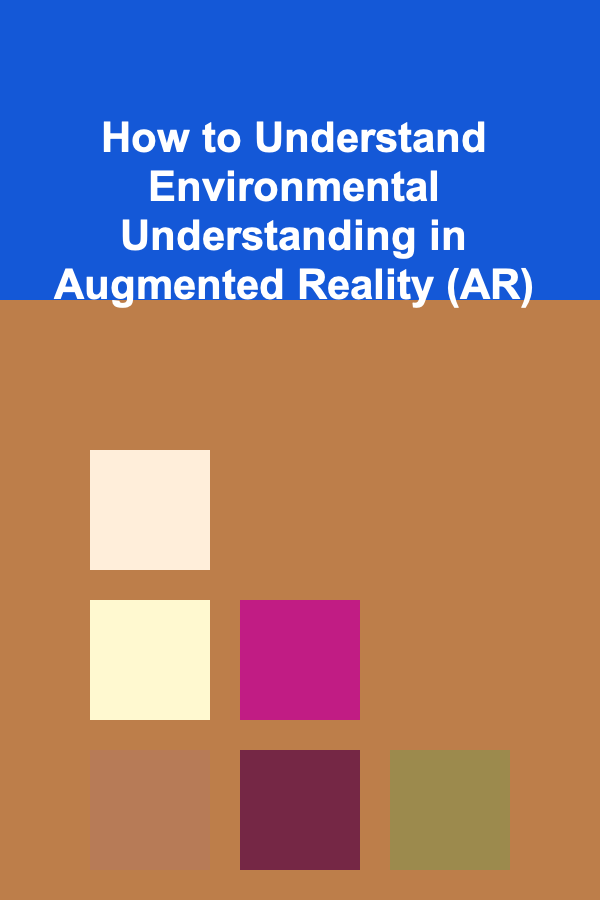
How to Understand Environmental Understanding in Augmented Reality (AR)
ebook include PDF & Audio bundle (Micro Guide)
$12.99$9.99
Limited Time Offer! Order within the next:

Augmented Reality (AR) is transforming the way we experience the world, blending the digital and physical realms in ways that were once imagined only in science fiction. One of the most critical elements that powers AR applications is "environmental understanding." This concept refers to the ability of AR systems to interpret and interact with the physical world in real-time, providing users with contextually relevant, immersive experiences.
This article delves deeply into the concept of environmental understanding in AR. We will explore its significance, the technologies that enable it, its applications, and the challenges that arise when attempting to create effective environmental understanding in AR systems. Whether you're an AR enthusiast, developer, or researcher, understanding environmental understanding is crucial to harnessing the full potential of AR.
The Significance of Environmental Understanding in AR
Environmental understanding in AR is the process through which AR systems sense, interpret, and interact with their physical surroundings. It involves identifying the geometry, properties, and relationships between various objects and spaces in the real world. This capability allows AR systems to overlay digital objects onto the real world, ensuring that these objects are placed in meaningful and coherent ways. Without robust environmental understanding, AR applications would fail to function effectively, as the system would not be able to perceive its surroundings accurately.
Key Components of Environmental Understanding
Several key components contribute to environmental understanding in AR. These include:
- Spatial Mapping: This refers to the ability of an AR system to create a 3D model of the environment in real-time. By capturing the geometry of the surroundings, the system can track the position of the user and adjust the placement of digital elements accordingly.
- Object Detection and Recognition: AR systems must be able to identify specific objects within the environment. This requires advanced computer vision techniques that allow the system to recognize and track objects, whether they are static or dynamic.
- Depth Sensing: Depth sensing is the ability to determine the distance between the AR device and objects in the real world. This is essential for placing digital objects in the right locations, ensuring they appear to exist naturally in the physical world.
- Motion Tracking: As the user moves, the AR system must track their position and orientation. This allows the system to adjust the placement of digital content in real-time, ensuring it stays in sync with the user's perspective.
- Semantic Understanding: Beyond geometric details, AR systems must also understand the meaning and context of objects within the environment. This could involve recognizing that a chair is for sitting, a table is for placing objects, or that a person is standing versus sitting.
Why Environmental Understanding is Crucial for AR
Environmental understanding is crucial for AR for several reasons:
- Immersion: Proper environmental understanding ensures that digital content integrates seamlessly into the physical world, creating a sense of immersion. When a virtual object is placed in an environment in a way that makes sense spatially, it feels like it belongs there, enhancing the user's experience.
- Interactivity: Environmental understanding allows users to interact with both real and virtual elements in meaningful ways. For instance, users can manipulate virtual objects by touching or moving them as if they were physical objects.
- Contextual Relevance: By understanding the environment, AR systems can offer contextually appropriate experiences. For example, an AR navigation app might adjust its directions based on the user's surroundings, while a shopping app might suggest virtual items based on a user's current location in a store.
Technologies Enabling Environmental Understanding in AR
Environmental understanding in AR relies on several core technologies. These technologies work together to allow AR systems to interpret the physical world and provide meaningful, interactive experiences.
1. Computer Vision
Computer vision is at the heart of environmental understanding in AR. It allows AR systems to "see" the world by interpreting images or video captured by cameras. Through computer vision, AR systems can identify objects, track movements, detect surfaces, and analyze the structure of the environment.
- Feature Detection: AR systems use feature detection algorithms (e.g., SIFT, ORB, SURF) to identify key points in an image, such as corners, edges, or textures. These points help the system understand the environment's geometry.
- SLAM (Simultaneous Localization and Mapping): SLAM is a technique used by AR systems to create a map of the environment while simultaneously tracking the device's location within that map. This is particularly useful for applications like navigation and real-time 3D mapping.
- Object Recognition: Deep learning algorithms, especially convolutional neural networks (CNNs), are increasingly used to enable AR systems to recognize objects and scenes in real-time.
2. Depth Sensing
To achieve accurate environmental understanding, AR systems must be able to sense the depth of the world around them. Depth sensing technology allows the system to measure the distance between the device and various surfaces or objects, making it possible to place virtual objects in a 3D space that reflects the true physical layout of the environment.
- LiDAR: Light Detection and Ranging (LiDAR) sensors emit laser beams to measure distances by analyzing the reflected light. LiDAR enables highly accurate depth sensing, providing detailed 3D maps of the environment.
- Stereo Cameras: Stereo vision uses two or more cameras to capture images from different angles. By analyzing the disparity between these images, the system can infer depth information.
- Time-of-Flight (ToF) Sensors: ToF sensors emit light pulses and measure the time it takes for the light to return to the sensor. This provides depth data for every pixel in the camera's field of view.
3. Machine Learning and AI
Machine learning and artificial intelligence play an increasingly important role in environmental understanding. By leveraging large datasets and training models, AR systems can learn to recognize objects, detect environments, and predict user actions.
- Neural Networks: Neural networks, particularly CNNs, are used for real-time object detection and recognition in AR. These networks are trained on vast amounts of visual data to identify patterns and features within images.
- Semantic Segmentation: AI-based semantic segmentation allows AR systems to divide an image into meaningful segments, such as people, furniture, or floors. This is crucial for applications like interior design or spatial planning, where objects need to be accurately placed within a space.
- Contextual Awareness: AI can be used to provide context-aware experiences, enabling AR systems to interpret the environment based on past interactions and user preferences.
Applications of Environmental Understanding in AR
Environmental understanding is foundational to the success of a wide range of AR applications. These applications span various industries, including entertainment, healthcare, retail, education, and more.
1. Gaming and Entertainment
One of the most well-known applications of AR is in gaming. AR games like Pokémon Go rely heavily on environmental understanding to place virtual creatures within the player's real-world environment. The system must understand the terrain, obstacles, and layout of the environment to ensure that virtual characters interact with it naturally.
In immersive entertainment, AR enables users to experience dynamic, interactive environments where digital content adapts to the surroundings. For example, in augmented theater experiences, characters and scenery might change based on the audience's position and actions within the space.
2. Retail and Shopping
Retailers are using AR to enhance the shopping experience by providing virtual try-ons and interactive product displays. Environmental understanding allows customers to visualize how products, such as furniture, clothing, or makeup, would look in their real-world environment.
- Virtual Try-On: AR apps allow users to try on clothing or makeup virtually by overlaying digital representations of these products onto the user's body or face. This requires accurate environmental understanding to ensure proper alignment and scaling of virtual items.
- In-Store Navigation: AR-powered shopping assistants can guide customers through a store by recognizing store layouts and offering contextual information, such as promotions and product details.
3. Healthcare and Medicine
In healthcare, AR is being used for training, surgery assistance, and patient education. Environmental understanding plays a key role in guiding surgeons by overlaying critical information, such as 3D models of organs or real-time vital signs, onto the patient's body.
- Surgical Navigation: AR systems can overlay real-time imaging data, such as CT scans or MRIs, onto a patient's body during surgery. This requires precise environmental understanding to align digital content with the physical body.
- Medical Education: AR can be used to teach medical students by providing interactive, 3D anatomical models that they can manipulate and explore in real-world environments.
4. Education and Training
AR has significant potential in education and training, providing immersive learning experiences. Environmental understanding enables AR systems to integrate learning materials with real-world objects, facilitating hands-on experiences in subjects like biology, chemistry, engineering, and history.
- Interactive Textbooks: Students can use AR to interact with educational content, such as visualizing complex scientific processes or historical events in 3D.
- Simulated Training: In industries like aviation or medicine, AR allows trainees to practice real-world tasks in simulated environments, where the system understands and reacts to the trainee's actions.
Challenges in Environmental Understanding for AR
Despite its potential, creating accurate environmental understanding for AR is not without challenges. Some of the main hurdles include:
- Real-Time Processing: AR systems require real-time processing to ensure smooth and responsive interactions. This demands significant computational power, especially when dealing with complex environments and large datasets.
- Environmental Variability: The diversity of real-world environments poses a challenge for AR systems. Variations in lighting, texture, and object types make it difficult to create systems that work consistently in all environments.
- Device Limitations: While smartphones and tablets are commonly used for AR, their processing power, camera quality, and sensor capabilities can limit the accuracy and responsiveness of environmental understanding. More advanced devices, such as AR glasses, are still evolving.
- User Interaction: Ensuring seamless interaction between users and the virtual content is another challenge. The system must not only understand the environment but also predict how users will interact with it, creating intuitive and responsive interfaces.
Conclusion
Environmental understanding is the cornerstone of augmented reality experiences. It allows AR systems to perceive, interpret, and interact with the physical world, enabling a wide range of applications in gaming, retail, healthcare, education, and more. As AR technology continues to evolve, advancements in computer vision, depth sensing, machine learning, and AI will make environmental understanding more accurate, responsive, and immersive.
Understanding the complexities and challenges of environmental understanding in AR is essential for anyone interested in developing or using AR technologies. As we move towards a more interconnected, digital-physical world, environmental understanding will play a pivotal role in shaping the future of AR experiences.

How to Clean and Maintain Your Wooden Floors Like a Pro
Read More
How to Leverage Technology to Track Your Financial Progress
Read More
How to Organize Your Wardrobe with the Right Storage Solutions
Read More
How To Build a Strong Social Media Presence Globally
Read More
The Soulmate Myth: Finding Love in Imperfect People
Read More
10 Tips for Sharpening Hand Tools Like a Pro
Read MoreOther Products

How to Clean and Maintain Your Wooden Floors Like a Pro
Read More
How to Leverage Technology to Track Your Financial Progress
Read More
How to Organize Your Wardrobe with the Right Storage Solutions
Read More
How To Build a Strong Social Media Presence Globally
Read More
The Soulmate Myth: Finding Love in Imperfect People
Read More